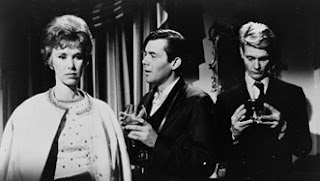by Douglas Messerli
Harold Pinter (screenplay), Joseph Losey
(director) The Servant / 1963
For several months now, I have waited for Netflix to add Joseph Losey’s 1963 film, The Servant, to their library. As sometimes happens in a city so devoted to filmmaking, fortunately, one of Los Angeles’ major independent theaters, Laemmle’s Royal, coincidentally announced a showing of a restored 50th anniversary version of the film, which Howard and I attended this Labor Day.
A few days ago, Los Angeles Times critic Kenneth Turan wrote an appreciative review of what he described as Losey’s “icy” masterpiece. Yet looking back on some of earlier reviews, it appears that most critics originally dismissed the film as inconsistent and, more importantly, unbelievable. As Tony Rayns wrote in the Time Out Film Guide: “Neither [Harold] Pinter’s pregnant dialogue nor the generally svelte performances can disguise the fact that there’s less here that meets the eye and ear.”
Certainly, few viewers might describe this film—which begins in quiet realism, with a slightly dim-witted young man hiring a manservant in order to help him with a new house he has just purchased—as being, by its decadently, almost hysterical ending, anything that anyone might actually believe to have occurred, even in the period of free-wheeling sexuality of 1960s London. But then, who might describe any of Losey’s sexual fables as even attempting to represent realism? One might even argue that throughout his career the American-born Losey has shared more with Ken Russell than anyone else in British cinema—but fortunately without Russell’s extravagance and kitsch. While there is a kind of “iciness” to Losey’s rich black and whites, there is also a great deal of “white heat” radiating from the slow-boiling emotional dependencies of its central characters, particularly between the needy and indolent Tony (James Fox), who imagines himself traveling to Brazil to create three new cities for “the natives,” and the dangerously deferential Barrett (Dirk Bogarde), who portrays the servant of the film’s title.
One
of the most absurd scenes of this film is Losey’s Fellini-like representation
of their heterosexual orgy, which occurs, evidently, with the participants
fully dressed, curling up, in turn, round one another like cold puppies. Only
Tony’s former fiancée, Susan, showing up to the house unexpectedly, seems to
have any sexual intentions, as she represents her shock at seeing her now fully
degraded former lover, by briefly embracing and kissing the servant whom
she has previously abused. In that last grab for power, she also recognizes
that she has lost everything that the house once represented: love, pleasure,
security, and wealth. And Barrett’s slam of the front door as she exits, soon
after, makes it apparent that it is he who is now in charge.
Earlier
in the film, Susan has asked Barrett “What do you want from this house?”
sensing that, like her, it is not the house’s owner he is truly after, but the
house itself, and what comes with it. Of course, in order to control the house,
he must first control Tony, and it is that manipulation upon which Pinter’s and
Losey’s work pretends to focus.
I would argue, however, that, instead of trying to
comprehend this film as a study of psychological revelations—although, of
course, all of Pinter’s works are filled with just that—that one might
perceive The Servant as a strange kind of horror film, a
version of the haunted house tale where things are never quite what they seem
to be.
Much
of the movie, indeed, is centered on the house’s upkeep, kept brilliantly
gleaming by Barrett in the first half of the film, and left to filth and decay
in the second half. If nothing else, the house more fully reveals the
characters’ conditions than do their own words and actions. And at film’s end
the house, more than the psychological games of its servant, has seemingly
declared for all the time the proper social position of its occupants, as the
former gentleman, Tony, lays sprawled drunkenly across its floor—fallen and
near-dead—and Barrett sneaks into Vera’s bedroom for a night of sex.
I
doubt that Losey actually thought of his film as fitting into the horror genre,
but to my way of thinking it helps us more fully to accept the melodramatic,
almost campy ending, and to recognize in whole The Servant as
a great work of art, a fable that, in fact, has a great deal to say about
colonization and class, and a society that is more dependent upon the symbols
of “living conditions” than on the condition of the living.
Los Angeles, Labor Day, 2013
Reprinted from World
Cinema Review (September 2013).






No comments:
Post a Comment